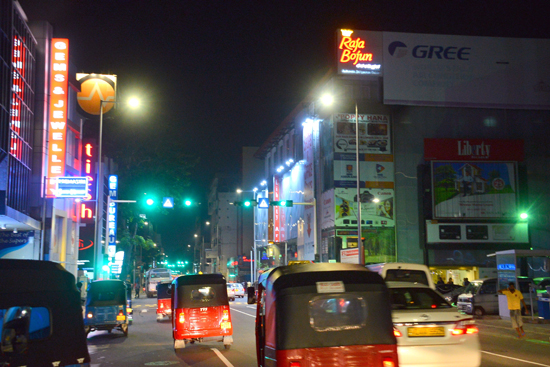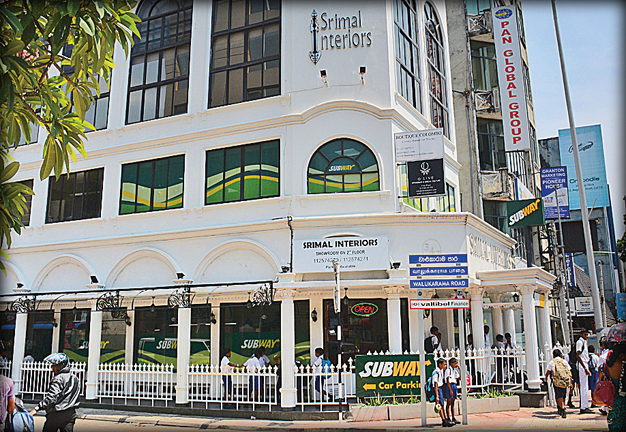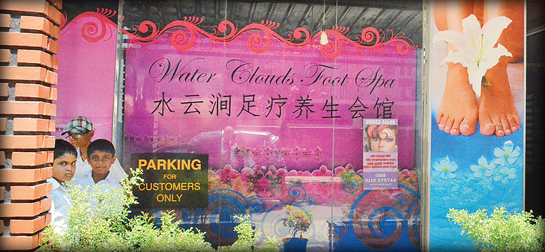Street
smart
Kishani Samaraweera takes a stroll down Duplication
Road and discovers many of its quirks and a little bit of its history:
 Once upon a time it was Sri Lanka’s snob street. No buses, no traffic
lights, no traffic jams. Home to high end shops, clubs, restaurants,
massage parlours, casinos and exclusive hangout joints, it had flair, it
had swagger, it had style, and most of all it had attitude. It had a
prosaic name – R. A. De Mel Mawatha – but everyone knew it as
Duplication Road. Once upon a time it was Sri Lanka’s snob street. No buses, no traffic
lights, no traffic jams. Home to high end shops, clubs, restaurants,
massage parlours, casinos and exclusive hangout joints, it had flair, it
had swagger, it had style, and most of all it had attitude. It had a
prosaic name – R. A. De Mel Mawatha – but everyone knew it as
Duplication Road.
It is still called R. A. De Mel Mawatha/Duplication Road, but
evolving traffic plans aimed at easing congestion, has meant the road
losing its snob status and opening up to plebeian transport and
irritating traffic lights at every hundred yard interval. There are more
vehicles and more people using this road now, making it one of the
busiest roads in Colombo. The traffic lights also make it one of the
more bizarrely decorated. So the question is, does it still have
attitude?
Extending 4.3 Km from Liberty Plaza roundabout Colpetty, to
Dharmarama Road, Wellawatte, it is still a shoppers’ paradise, pandering
to the consumer in you. Detach yourself from the need to splurge, and
walking this once Snob Street can be a fascinating experience,
especially given the various types of shops that line the street.
The road gets insanely busy in the afternoon and in the evening. The
ideal time for a walkabout would be the evening as the road gets
completely transformed once it is dark, taking on a magical mien with
colourful lights and happy people, laughing, jostling, shopping, looking
for something different, something new…
Growing infamy
Night life is vibrant on this road, and the sidewalks teem with
locals and visitors looking for fun, food and music. Some of the best
casinos in the country are found on this road, and attract both
foreigners and locals like.
 Another
noticeable attraction is the spas or massage parlours, or at least
that’s what the name boards say. Interestingly most of them are run by
Chinese or Thai nationals. The kind of services these places offer is
left for conjecture, but word on the street is that what’s on offer is
much, much more than an simple, innocuous massage. Another
noticeable attraction is the spas or massage parlours, or at least
that’s what the name boards say. Interestingly most of them are run by
Chinese or Thai nationals. The kind of services these places offer is
left for conjecture, but word on the street is that what’s on offer is
much, much more than an simple, innocuous massage.
The conjecture nicely segues into Duplication Road’s growing infamy
as the best place to find sex workers. As the peak hour traffic slows
down to a trickle, and night life unfolds, skimpily dressed women, Sri
Lankan, Chinese, Thai, Korean, and even Russian, move on to the sidewalk
striving to attract customers.
It is interesting that except for a few people, there are not many
people walking along the Duplication Road during day time. But the story
is different at night. One would never imagine that such a dull and
boring street during the day would turn into a vibrant and lively strip
at night.
Walking along the road, it is hard not to notice that there are only
a very few residential houses left on the ever changing road, with many
road front properties being sold to make way for multi-storeyed
buildings or artfully converted to shops, boutiques and restaurants.
The character of Duplication Road has been evolving since early
1980s. Ratnam (62) who comes to the community centre to spend his
leisure time has been a resident of Duplication Road for over 60 years.
He says, initially the road was only from Liberty circus to the Fifth
Lane, and was less than five feet in width.
 “Earlier
the road was quite narrow and there was space for only one vehicle. It
all started to change from 1983-84. Today Duplication Road is a
completely different road, which has mainly commercial buildings,” he
says. “Earlier
the road was quite narrow and there was space for only one vehicle. It
all started to change from 1983-84. Today Duplication Road is a
completely different road, which has mainly commercial buildings,” he
says.
He’s not happy with the transformation of the road and keeps
repeating, “There are too many buildings now and nothing more. This road
used to be a ‘highly residential’ area.”
Kumar, a three wheeler driver on Duplication Road for the past 25
years mentions that the residents of the area consisted of rich people,
mostly. But now their houses have been sold, leased or given on rent for
business places due to the growing demand for spaces commercial
purposes.
Commercial value
“When we were schooling, this used to be a gravel road. Only a part
of it was carpeted. It was a very small road,” Kumar recalls.
He also says the land value is quite high on Duplication Road, with a
perch being sold for as much as Rs 10-15 million, as it has very good
commercial value. Most of the properties have been converted to
boutiques, offices or banks.
 Jayantha
A. Guruge, Director Engineering (Works), Municipal Engineers Department,
Colombo Municipal Council, says the commercialisation of the Duplication
Road started during 1980s, prior to which it was a residential area. He
says it is now a mix development. Jayantha
A. Guruge, Director Engineering (Works), Municipal Engineers Department,
Colombo Municipal Council, says the commercialisation of the Duplication
Road started during 1980s, prior to which it was a residential area. He
says it is now a mix development.
“Duplication Road faced rapid development in the early ’90s and today
it is one of the highly commercialised areas in Colombo. After the one
way traffic scheme was introduced in 2012, it became one of the
significant roads,” notes Guruge.
Explaining why Duplication Road was built, he says it was developed
as an access road parallel to Galle Road, and notes that no commercial
development was permitted by the then authority. However during 1980s
the Urban Development Authority relaxed the policy.
The road, according to Guruge had been developed with Rs 1200 million
in World Bank funding. |

